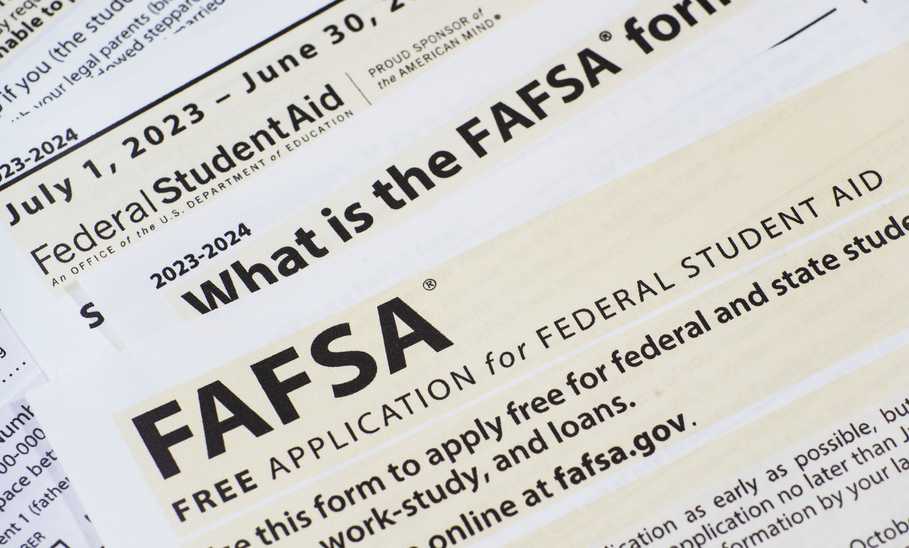What is FAFSA? A Complete Guide to Federal Student Loans

Our evaluations and opinions are not influenced by our advertising relationships, but we may earn a commission from our partners’ links. This content is created by TIME Stamped, under TIME’s direction and produced in accordance with TIME’s editorial guidelines and overseen by TIME’s editorial staff. Learn more about it.
FAFSA stands for Free Application for Federal Student Aid, and it’s the document you must fill out and submit to be considered for student loans and grants from the government. While federal financial aid is partially determined by your Expected Family Contribution (i.e., how much money your family makes and can pay out of pocket), any student can submit a FAFSA regardless of income. And since it’s free, you probably should.
Each individual college has its own financial aid application deadline, which usually includes filing the FAFSA. (Even if you hope to get aid directly from your school, they may require you to file at the federal level first.) However, an overarching federal deadline also applies, which is June 30, 2025, for the 2024-2025 school year.
While it may seem like you have a lot of time, applying soon after the FAFSA launches for the best shot at the most financial aid money is best. In addition, some recent, well-publicized problems with the FAFSA—ironically following changes made to simplify the process—have led to costly errors and delays in some cases. Long story short: The right time to fill out the FAFSA is now.
While the FAFSA is open to students of any income level, there are some basic eligibility requirements you’ll need to meet to successfully receive student aid. These include:
While higher-income students can submit a FAFSA, they will likely receive less aid than those who demonstrate greater financial need.
Lower-income students may also receive subsidized federal loans (for which the U.S. Department of Education pays the interest during your enrollment and for the first six months after you leave), as well as opportunities for aid that may not need to be paid back, such as grants and work-study opportunities.
Your FAFSA may help your school qualify you for any financial aid they award directly to students, as well as state aid. While some merit-based scholarships don’t rely on FAFSA data to qualify applicants, it may qualify you for other need-based scholarships and grants.
Given how costly college is, there’s no good reason not to file a FAFSA—aside from the fact that it's a bit of a clunky document. The government has recently been trying to improve this, though the efforts have had some unfortunate side effects.
It’s been hard to avoid the headlines about the “new FAFSA,” an updated online form released on Dec. 30, 2023. The Federal Student Aid Office promised it would be a “better” form, but unfortunately, the rollout was not a smooth one.
Along with a streamlined online application—reducing what could have been as many as 108 questions down to as few as 18—the new FAFSA also came with updated rules that would expand access to Pell Grants, ostensibly getting more aid to students with greater financial need.
But technical issues meant the application, usually available in October, wasn’t live until three months later, shrinking the time students and their families had to fill it out. Immediately after it went live, additional “pauses” for site maintenance made the FAFSA’s availability unpredictable. In the months since, multiple glitches, calculation errors, and other issues have surfaced.
All have had a serious impact on students hoping to apply for student aid or just go to school. In some cases, families had to scramble to correct errors caused by technical glitches (which can impact or delay schools’ aid decisions). According to reporting by CNN, only 37% of high school seniors had completed the form by April 12, 2024, down from 50% by the same date in 2023.
While correcting an already-filed FAFSA is possible, doing so requires more steps (which is the opposite of what this update was meant to offer to families). Additionally, the academic school year waits for no one, so inaccuracies may lead to costly situations for some students and unexpected gap years for others.
The deadline to make regular corrections to a FAFSA usually occurs in September, though these mass inaccuracies and glitches are unprecedented. While colleges are aware of these issues and the Department of Education is scrambling to correct its many mistakes, the situation continues to develop.
Though there’s no accounting for any additional glitches that may crop up, which may cause further delays, there are three main FAFSA deadlines to be aware of:
Most years, the FAFSA becomes available on Oct.1 of the year before its June deadline (though again, this was different for the 2024-2025 school year). The earlier you apply, the better—that way, you ensure you don’t miss any deadlines and have the highest chance at available aid.
While the Department of Education recommends applying online to speed the process, you can still submit a FAFSA by mail for the 2024-2025 school year. (The PDF form is available here). Remember to file a new FAFSA every year you wish to seek financial aid.
Those applying online will need to sign up for a studentaid.gov account, which you can also use to sign your master promissory note (to receive any loans you’re eligible for and agree to), as well as to explore repayment plans to find one that works best for you.
Online FAFSAs are filled out by several different “contributors”—a new term rolled out for the 2024-2025 FAFSA. Contributors are the various parties who help complete the application, and who must provide consent to have their federal tax information transferred directly from the IRS to the form. Contributors may include your parents, step-parents, or spouse, depending on your dependency and marital status.
Each contributor will need their own studentaid.gov account. Once you log into your account and begin the FAFSA, you can invite them to fill out and sign their parts by entering their name, Social Security number if they have one, and email address. Not all contributors need a Social Security number, but students do.
Ideally, most tax information will be transferred directly from the IRS. But if you need to manually enter anything, it’s a good idea to gather tax returns, child support records, bank statements, and investment records.
Once you log into your studentaid.gov account using your username and password, you can select “Start New Form.” You can also save your application part-way through and access it later. The system will guide you through the questions you need to answer, and you’ll list the schools you want the information to be dispersed to right on the form itself.
If you need further assistance, contact your prospective school’s financial aid office, or call the Student Aid Information Center at 1-800-4-FED-AID (1-800-433-3243).
While the 2024-2025 FAFSA rollout hasn’t been without its share of drama, filling out the FAFSA is still the best way to ensure you’re considered for all the financial aid you can possibly receive. Just be sure you file as soon as possible—not only to stave off any missed deadlines but also to get ahead of any further delays.
The IRS data retrieval tool is the program that allows federal tax data to be automatically transferred from the IRS to the FAFSA, which is meant to help speed the process for the 2024-2025 application period. Multiple glitches and calculation errors have scuttled the Department of Education’s hope for a smooth launch of the new system and, unfortunately, some students’ hope of submitting a complete FAFSA on time.
The Student Aid Information Center can be reached by phone at 1-800-4-FED-AID (1-800-433-3243). The Federal Student Aid office also offers a “Contact Us” page to connect you or your parents to representatives via telephone, email, or chat.
Except for those who live in the Republic of the Marshall Islands, Federated States of Micronesia, or the Republic of Palau, all students filing the FAFSA must have a valid Social Security number. You must also be a U.S. citizen or eligible non-citizen, including permanent residents, refugees, and asylum-seekers who’ve received an Arrival-Departure Record (I-94) from Immigration Services.
There’s no specific set cutoff for receiving financial aid—though the lowest-cost options are reserved for students and families who can demonstrate financial need. Even if your parents make more than $100,000, it’s worth applying to see what you might be eligible for. The FAFSA also helps qualify you for aid from your state, school, and the federal government.
The information presented here is created by TIME Stamped and overseen by TIME editorial staff. To learn more, see our About Us page.



